Have you heard the story about how residents of Los Angeles freaked out when they saw a strange silvery cloud in the night sky? The blackout after a 1994 earthquake meant that Angelenos were seeing stars – and other celestial objects such as the Milky Way – for the first time. Legend now says that worried stargazers called 911, but the more likely story is that the local observatories received some late-night phone calls from those curious as to what they were seeing.
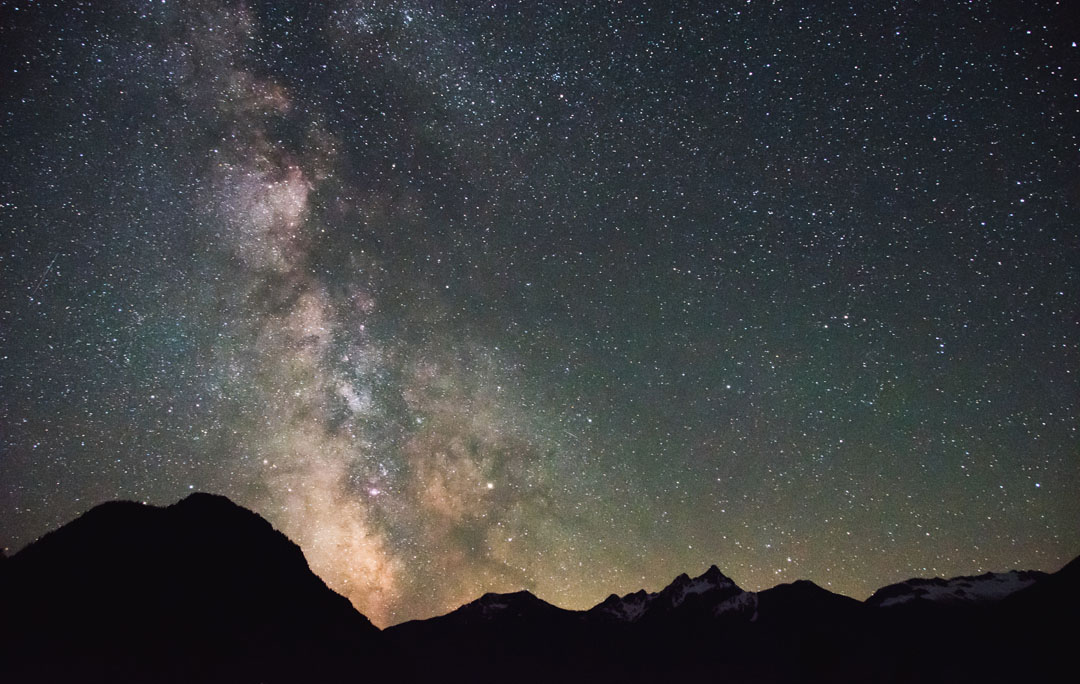
Citizens in Los Angeles weren’t sure what the large sky in the cloud was during a 1994 blackout – it was the Milky Way
Whether exaggerated or not, the point of the story remains true – most Americans (an estimated 80%, in fact), are not able to see the Milky Way from where they live.
What is light pollution?
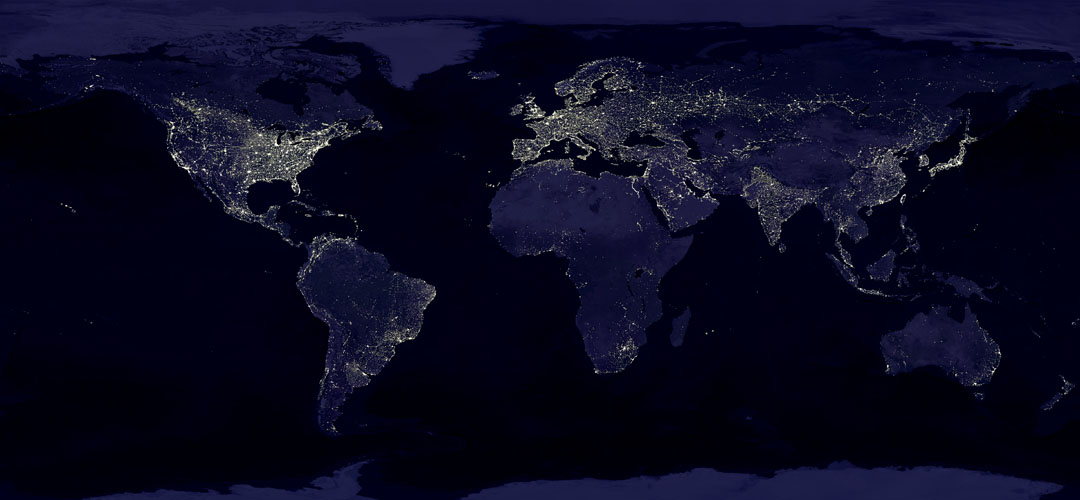
Light pollution from 1995
All light contributes to light pollution, but the worst offenders are lights pointed up towards the sky (like some stadium lights), most LED lights, and any lights that are blue light. If you’re not familiar with color temperatures, let’s break it down quickly. Note that these lights all look white to our eyes.
Blue/Cool Light
The sun produces blue light (this is why the sky appears blue). Our body reads it as a symbol that it’s time to be awake. Blue light during daylight hours boosts attention, mood, and reaction times. Artificial blue light comes from our phone screens, computers, televisions, tablets, and most florescent and LED lights (including street lights). Blue and cool lights have a higher color temperature.
Orange/Warm light
On the opposite side of the color spectrum is warm light. Sources of warm light include a campfire, a candle, or most older (non-LED) style light bulbs. Warm lights have a lower color temperature.
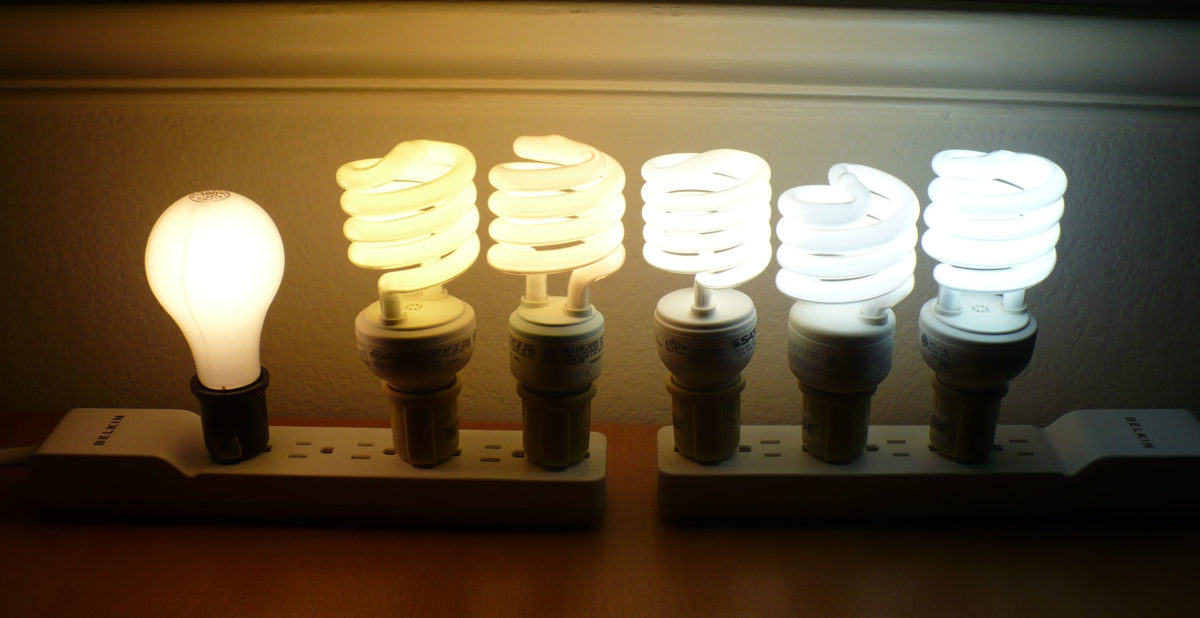
Comparison of the color temperature of 5 CFLs and one incandescent lamp. From left to right: 100 watt soft white incandescent, 2700K CFL, 3500K CFL, 4100K CFL, 5500K CFL, 6500K CFL. All CFLs are 100 watt replacements, ranging from 23 to 26 watts. From Wikimedia
Remember, the lights will not look blue or orange. They’ll probably look white. So pay attention to packaging/information.
Light pollution is making astronomy (and star gazing) more difficult
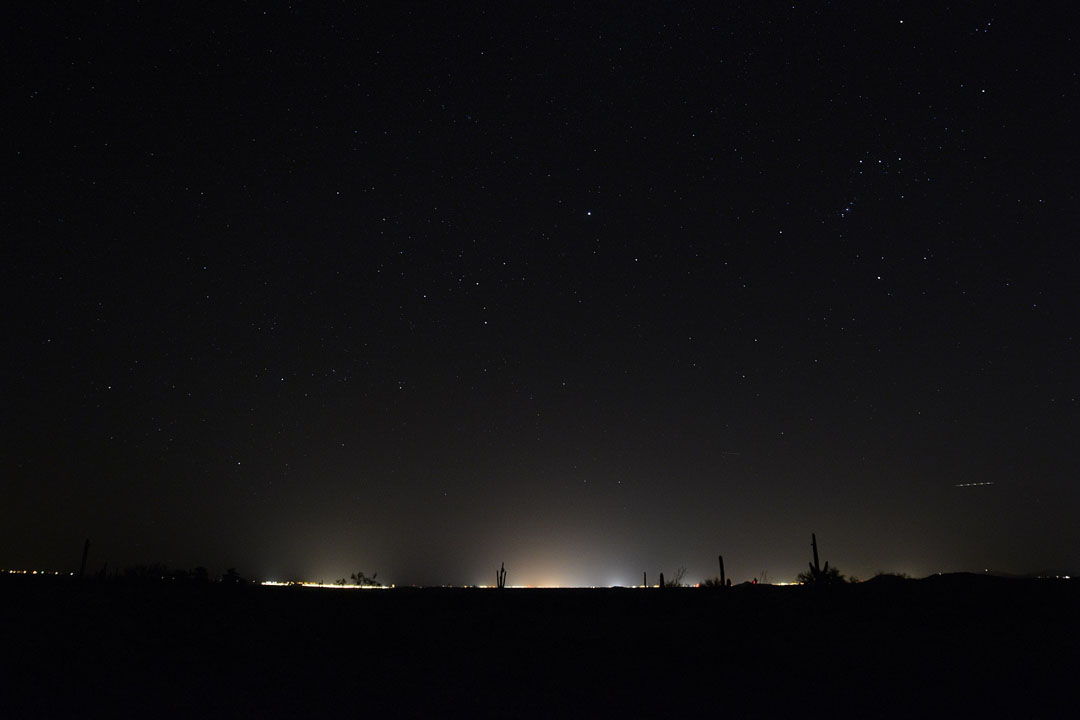
The lights of Phoenix are clearly visible – and are negatively impacting the amount of stars seen – 55 miles away
Gppercy [CC BY-SA 4.0 (https://creativecommons.org/licenses/by-sa/4.0)]
Light (and light pollution) affects wildlife
Baby sea turtles

Sea turtle hatchlings only survive if they make it to the sea quickly – before they are snatched by predators
Have you ever seen a video of tiny sea turtles emerging from the sand and making their adorable journey to the sea? Scientists believe that the turtles move away from dark sand dunes and vegetation in order to find the ocean. But with artificial lighting nearby, turtle hatchlings are getting confused and wandering the wrong direction – which usually means that they won’t survive.
Migratory birds
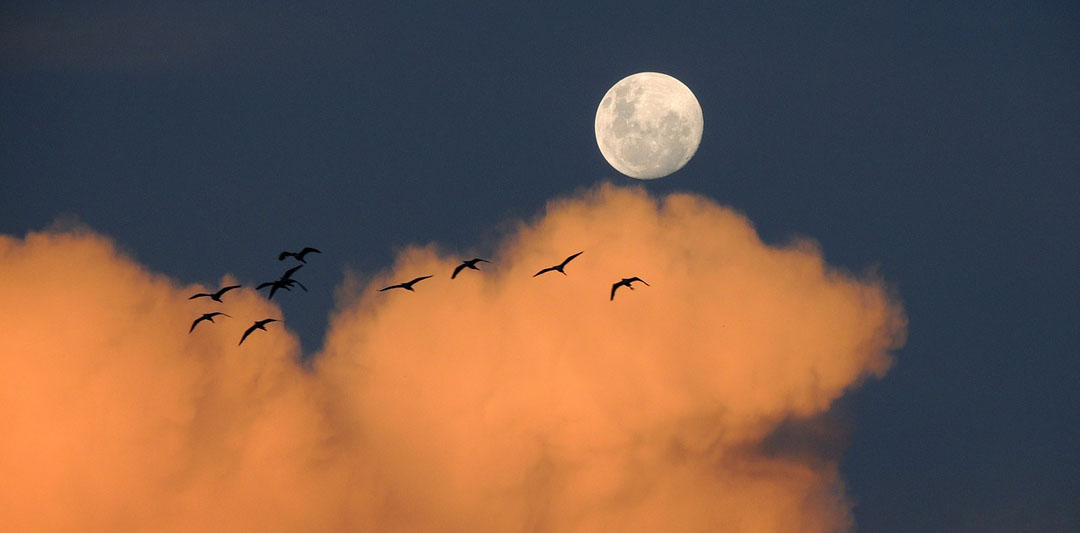
Migratory birds use the safety of darkness and the light of the moon to guide their way
Migrating birds also use the nighttime illumination of the moon (and the safety of darkness from predators) to navigate. When these flocks of birds get too near a bright city, they become disoriented and confused. According to the dark sky foundation, 1 to 10 birds die by colliding with each building every year. For those that don’t collide, there are stories of birds circling and circling until they eventually collapse from exhaustion.
For a fascinating look at how the NYC 9/11 memorial beams of light affect migratory birds every year, check out this article (spoiler alert: if too many birds start circling, they turn the lights off for 20 minutes and the birds are able to reorient themselves).
Other animals
Predatory animals usually hunt during the day, which leaves the hunted only the nighttime hours to safely travel and/or gather food themselves. With artificial light, some frogs don’t know to make their nighttime mating call, so their species is dwindling.
Evidence of adverse effects from lighting can be found all over the animal kingdom. But did you know it’s harming our health as well?
Light affects health
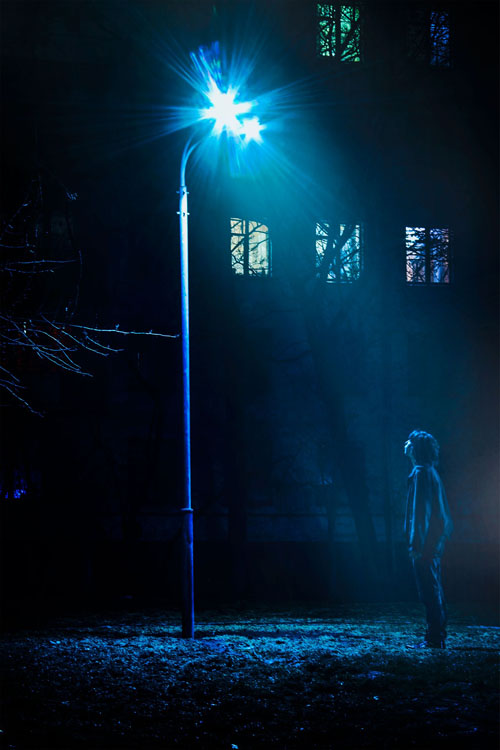
LED street lights in metropolitan cities have meant poorer sleep for some citizens
Light pollution messes with our sleep
Blue-light blocking glasses are very popular as of the writing of this article because we are realizing that the screens that we stare at all day are negatively affecting our sleep.
Any light at night can have adverse effects on our health because it suppresses melatonin secretion, a natural hormone that helps us sleep. According to a Harvard study, blue light is twice as powerful at suppressing melatonin as other types of light.
Have you ever heard that going camping for a few days will regulate your sleep schedule if it’s been off? That’s because, out in nature, you have plenty of blue light during the day, and, ideally, nothing but the dark night sky at night. This “resets” your circadian rhythm, the natural tendency of our body to align our sleep schedule with nature.
It’s not just our electronics – many cities have switched to LED street lighting as LED bulbs are more cost-efficient. But according to the Dark Sky Foundation, LED street lighting is not a great idea:
“Not only is blue-rich white LED street lighting five times more disruptive to our sleep cycle than conventional street lighting…but recent large surveys have documented that brighter residential nighttime lighting is associated with reduced sleep, impaired daytime functioning and a greater incidence of obesity.”
Blue light causes eye strain
Another reason that those blue-blocking lenses are becoming so popular is because the flickering of artificial blue light can cause digital eye strain.
According to All About Vision,
“Because short-wavelength, high energy blue light scatters more easily than other visible light, it is not as easily focused. When you’re looking at computer screens and other digital devices that emit significant amounts of blue light, this unfocused visual ‘noise’ reduces contrast and can contribute to digital eye strain.”
There are studies that have linked artificial blue light to greater risks of certain types of cancers, as well as greater risk of diabetes, heart disease, and obesity. Increased risk of depression was also noted.

Too much blue light messes with our sleep, causes eye strain, and may lead to other health issues
Blue light increases glare
We’ve all been blinded by those new LED headlights on cars, and now you know that the blue light from most LEDS scatters, which is one of the reasons why those headlights are so painful when they’re coming towards you. They also increase glare, which can be dangerous for other drivers on the road.
LIGHT AFFECTS PLANTS
Similar to wildlife and to humans, plants need blue light during the day to grow. But as with everything else that we’ve mentioned, too much blue light is a bad thing. So keep this in mind when you are planning landscape lighting. Plants and trees use light as a signal. Some native desert plants like creosote save energy by only photosynthesizing in the early morning light, for instance. Some studies have shown that trees near street lights lost their leaves later – because they didn’t realize that the days were shorter and fall had arrived.
Use extra caution with outdoor lighting if you’re trying to grow a night-blooming flower. Most night-blooming flowers rely on a specific type of moth for pollination, which can be scared off by artificial light.
For indoor plants, Christmas cactus and poinsettias are particularly sensitive to artificial light – they need 12 to 14 hours of darkness to produce blooms at the appropriate time.
So, knowing all this about light pollution and blue lights specifically, what can one do?
Light Pollution and You
For your personal health, try to eliminate blue light exposure after dark. Use blue-blocking glasses or switch the screen of your electronics to nighttime mode.
Here are some ways you can make your landscape lighting work for wildlife, astronomers, and your fellow Tucsonans:
- View the outdoor lighting codes for Pima County. Tucson is a dark-sky city so make sure you are following the law
- Read up on the outdoor lighting basics from the International Dark-Sky Association
- Be a good neighbor. Make sure you’re not guilty of light trespass, which is light from your property reaching another’s. They are allowed to file a complaint if your outdoor light disturbs them or their property.
- Reduce outdoor lighting whenever possible
- Turn off lights when not in use
- Ensure lights face downward and/or are shaded from above so that the light does not shine up
- Don’t use blue lights. Look for a color temperature of 3000K or below
- Purchase dark-sky approved lighting
- Check out these illustrations for how to reposition, replace, or properly install outdoor lighting
- This infographic from Inside Science is a helpful guide
Did you know that Tucson is known as the leader in the dark sky movement? Astronomy brings a lot of money to our state. The International Dark-Sky Association was founded here. Below the University of Arizona Stadium is a giant mirror lab, creating giant mirrors to be used in telescopes to view the night sky, and you can visit the observatory at the Flandrau Science Center & Planetarium to view at the moon, planets, or the stars from its 16-inch telescope. It’s one of my favorite places to take out-of-town visitors. I took my very stoic, calm younger brother there once and he was bouncing with excitement after looking through the telescope. One writer from the Washington Post detailed his astronomy-themed trip to Tucson and found plenty to do.
Outdoor lighting options
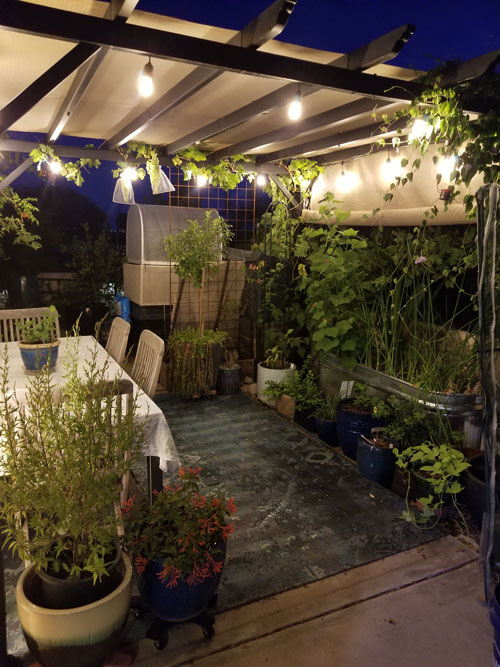
Outdoor lighting can enhance your outdoor area without ruining the night sky
Landscape lighting can help you enjoy your yard during the cooler evening hours and gives you more opportunities to enjoy the outdoors. With dark-sky approved lighting that follows the lighting codes, you can spend more time in your yard while knowing that you’re not ruining the experience for others.
Here are some ways that you can use outdoor lighting to enhance your space:
- Line a walkway with solar lights
- Light a pergola with string lights – just be sure to turn them off when not in use. In the picture shown, the pergola cover is blocking the lights from shining upwards, reducing light pollution into the sky
- Use a motion sensor for front door and sidewalk areas – this ensures that it’s only being used when needed. Be sure that it’s facing down and that the color temperature is consistent with Dark Sky recommendations (3,000K or below).
- Highlight a wall, pool, or tree – again, make sure they are facing down, not up into the sky. This saves you money as you’re not wasting half of the light, and it ensures that you’re not contributing to the light pollution problem.
We hoped this helped you discover some new ways to add outdoor lighting to your property without adding to the light pollution problem our world faces. Have fun and enjoy your outdoor space!